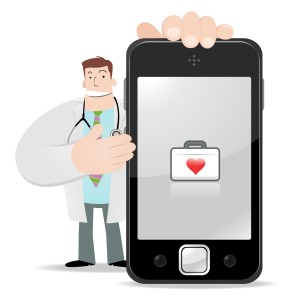 There’s been an surge in technology tools for health in the past few years, with some really interesting apps and gadgets coming to market. They hold promise to help people engage closely with healthy behaviors.
There’s been an surge in technology tools for health in the past few years, with some really interesting apps and gadgets coming to market. They hold promise to help people engage closely with healthy behaviors.
The tools can be broken down roughly into four categories: educate, connect, track, and remind. The more interesting apps combine multiple functions. Here are some buzz-worthy health tools I’ve seen at health IT conferences in the last couple of years – through the filter of a non-techy person.
Smart phones have unbelievable potential to help you manage your behaviors, both positive and negative. The top ten apps on iTunes include calorie counters, personal trainers, and sleep aids, including an app that sets a baseline for your movement during sleep and then wakes you when you are in your lightest cycle. Smart phones can deliver education and hot triggers – the text messages or email reminders that tell you to put down the cookie and walk away.
In addition to your smartphone are the standalone tracking devices. The Fitbit uses a 3D motion sensor (like the one found in the Nintendo Wii) you wear day and night to track your calories burned, steps taken, distance traveled and sleep quality. It syncs wirelessly with your computer and provides online tools to manage your information and connect with like-minded Fitbitters. Nike has been in this game for a while with its Nike+ line, letting you record and download your cardio stats. They’ve added various GPS features in the past six months, and all their products connect users with a 3-million strong running community. I saw the most adorable counter-top robot at a conference last fall. The robot has a short conversation with you every day to help you keep track of your eating and exercise. She provides feedback, advice, and encouragement to keep you motivated. Initially sceptical, I left the talk trying to figure out how to justify the $700 price tag.
Your computer is the ultimate gizmo, and offers lots of choice in techo tools. Its strength is in education and connection. There are a lot of grassroots patient online groups that are run by volunteers and they are invaluable for patients with chronic conditions, particularly those with rare diseases and with difficult-to-diagnose conditions. If you’ve run into something bigger than you can handle, or you’ve run out of ideas for treatments, others in the similar situations can provide invaluable support and ideas. Groups are available as email lists, newsgroups (Yahoo and Google Groups), chat rooms, blogs and social networking sites like Facebook.
There are a few private companies that offer patient support groups on steroids – PatientsLikeMe and CureTogether are a couple of examples. They offer forums to connect with other patients around selected diseases, but also require you to give them detailed data about your symptoms and treatments. They crunch the data and then reflect back what users are experiencing with their chronic conditions.
CaringBridge provides a template for personal websites created by patients during a health crisis. It allows friends and family to keep updated and offer support in one central portal. A friend used it when his wife was undergoing cancer treatments. He found it useful, but fairly commercial.
This is a woefully brief overview of this whole area and barely gives it justice. And I didn’t even get to gaming for health, a really interesting development. Each of these categories deserves a post of its own – stay tuned.
